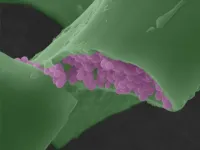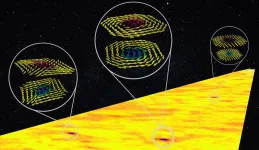(Press-News.org) Treating equine donor stem cells with a growth factor called TGF-β2 may allow them to avoid "tripping" the immune response in recipients, according to new research from North Carolina State University. The work could simplify the stem cell treatment process for ligament and tendon injuries in horses, and may also have implications for human stem cell therapies.
Mesenchymal stem cell therapy is a promising avenue for treating musculoskeletal injuries - particularly tendon and ligament injuries - in horses. Mesenchymal stem cells are adult stem cells found in bone marrow that act as repair directors, producing secretions that recruit paracrine, or healing, factors to the site of injury.
Just as blood cells have "types," depending upon which antigens are on the blood cell's surface, mesenchymal stem cells have differing sets of major histocompatibility complex molecules, or MHCs, on their surfaces. If the MHCs of donor and recipient aren't a match, the donor's stem cells cause an immune response. In organ transplants, MHCs are carefully matched to prevent rejection.
"These treatments aren't like a bone marrow transplant or an organ transplant," says Lauren Schnabel, associate professor of equine orthopedic surgery at NC State and corresponding author of the work. "Since the mesenchymal stem cells are being used temporarily to treat localized injury, researchers once thought that they didn't need to be matched - that they wouldn't cause an immune response. Unfortunately, that isn't the case."
Schnabel and Alix Berglund, a research scholar at NC State and lead author of the paper describing the work, wanted to find a way to utilize mesenchymal stem cell therapy without the time, effort and additional cost of donor/recipient matching.
"Since these cells don't have to be in the body as long as an organ does, 'hiding' them from the immune system long enough for them to secrete their paracrine factors could be a way around donor/recipient matching," Berglund says. "Downregulating expression of the MHC molecules could be one way to do this."
The researchers cultured stem cells and lymphocytes, or T cells, from eight horses, cross-pairing them in vitro so that the stem cells and lymphocytes had differing MHC haplotypes. In one group, stem cells had been treated with transforming growth factor beta (TGF-β2) prior to being added to the lymphocytes in the culture media; the other group was untreated. TGF-β2 is a cell-signaling molecule produced by white blood cells that blocks immune responses.
Cultures with treated stem cells had a 50% higher stem cell survival rate than untreated cultures.
"We use mesenchymal stem cells to treat musculoskeletal injuries - particularly tendon injuries - in horses very effectively," Schnabel says. "And while you can extract the secretions from the stem cells, you get better results with the cells themselves. Stem cells aren't just a reservoir of secretions, they're a communications hub that tells other cells what they should be doing. So finding a way to utilize these cells without stimulating immune response gives us better treatment options."
"This is a promising pilot study," Berglund says. "Our next steps will be to further explore the immune response in vivo, and to look at human cells in vitro, as this work has excellent potential to help humans with these injuries as well."
The research appears in Frontiers in Cell and Developmental Biology, and was supported by the National Institutes of Health (grants K08AR060875 and K01OD027037) and the Morris Animal Foundation (grants D16EQ-405 and D18EQ-055). Research specialist Julie Long and statistician James Robertson, both of NC State, also contributed to the work.
INFORMATION:
Note to editors: An abstract follows.
"TGF-b2 Reduces the Cell-Mediated Immunogenicity of Equine MHC-Mismatched Bone Marrow-Derived Mesenchymal Stem Cells Without Altering Immunomodulatory Properties"
DOI: 10.3389/fcell.2021.628382
Authors: Alix K. Berglund, Julie M. Long, James B. Robertson, Lauren V. Schnabel, North Carolina State University
Published: Feb. 4, 2021 in Frontiers in Cell and Developmental Biology
Abstract:
Allogeneic mesenchymal stem cells (MSCs) are a promising cell therapy for treating numerous diseases, but major histocompatibility complex (MHC)-mismatched MSCs can be rejected by the recipient's immune system. Pre-treating MSCs with transforming growth factor-b2 (TGF-b2) to downregulate surface expression of MHC molecules may enhance the ability of allogeneic MSCs to evade immune responses. We used lymphocyte proliferation assays and ELISAs to analyze the immunomodulatory potential of TGF-b2-treated equine bone marrow-derived MSCs. T cell activation and cytotoxicity assays were then used to measure the in vitro cell-mediated immunogenicity. Similar to untreated MSCs, TGF-b2-treated MSCs inhibited T cell proliferation and did not stimulate MHC-mismatched T cells to proliferate. Additionally, similar quantities of prostaglandin E2 and TGF-b1 were detected in assays with untreated and TGF-b2-treated MSCs supporting that TGF-b2-treated MSCs retain their strong immunomodulatory properties in vitro. Compared to untreated MSCs, TGF-b2-treated MSCs induced less T cell activation and had reduced cell-mediated cytotoxicity in vitro. These results indicate that treating MSCs with TGF-b2 is a promising strategy to reduce the cell-mediated immunogenicity of MHC-mismatched MSCs and facilitate allogeneic MSC therapy.
Gels are formed by mixing polymers into fluids to create gooey substances useful for everything from holding hair in place to enabling contact lenses to float over the eye.
Researchers want to develop gels for healthcare applications by mixing in medicinal compounds, and giving patients injections so that the gel releases the active pharmaceutical ingredient over a period of months to avoid weekly or daily needle sticks.
But standing in the way is a problem that's as easily understandable as the difference between using hair gel on a beach versus in a ...
Virtual 'exergaming' has become a popular way to exercise - especially among younger people - since the release of virtual reality (VR) fitness games on consoles such as Nintendo and Playstation.
But while VR is undoubtedly raising fitness games to a whole new level, researchers at the University of South Australia are cautioning players about the potential side effects of VR, particularly in the first hour after playing.
In a new study published in the Journal of Medical Internet Research, UniSA researchers investigated the consequences of playing one of the most popular VR exergames - Beat Saber* - finding that one in seven players still ...
Catalysts are key materials in modern society, enabling selective conversion of raw materials into valuable products while reducing waste and saving energy. In case of industrially relevant oxidative dehydrogenation reactions, most known catalyst systems are based on transition metals such as Iron, Vanadium, Molybdenum or Silver. Due to intrinsic drawbacks associated with the use of transition metals, such as rare occurrence, environmentally harmful mining processes, and toxicity, the fact that pure carbon exhibits catalytic activity in this type of reaction and thus has high potential as a sustainable substitution material is of high interest.
To date, the development of carbon-based catalysts for oxidative dehydrogenation reactions may be divided into two ...
UCC palaeontologists have discovered new evidence that the fate of vertebrate animals over the last 400 million years has been shaped by microscopic melanin pigments.
This new twist in the story of animal evolution is based on cutting-edge analyses of melanin granules - melanosomes - in many different fossil and modern vertebrates, including fish, amphibians, reptiles, birds and mammals. Melanin and melanosomes have traditionally been linked to outermost body tissues such as skin, hair and feathers, with important roles in UV protection and stiffening of tissues. Analyses of where different animals store melanin in the body, however, show that different vertebrate groups concentrate melanin in different organs, revealing ...
Ultrasound is not only used as an imaging technique but targeted pulses of ultrasound can be used as a highly accurate treatment for a range of brain diseases, for which there were previously only limited treatment options. Over the last few years, several revolutionary techniques of this kind have been developed, primarily in Toronto but also at MedUni Vienna. The Viennese technique improves brain functions by externally activating neurons that are still functional. Improvements can be expected in various neuropsychiatric brain diseases such as Alzheimer's, Parkinson's, stroke, Multiple Sclerosis, and neuralgia. A review jointly written by ...
Researchers at NUI Galway have identified genomic signatures in women developing the most common type of breast cancer that can be associated with long-term survival. The NUI Galway team analysed the genomes of breast cancer patients to look for associations with survival rates using advanced statistical techniques.
Carried out by Lydia King during her studies in NUI Galway's MSc in Biomedical Genomics programme, the research has been published in the international journal PLOS ONE.
Early detection by national screening programmes and timely treatment for patients diagnosed with "luminal" types of breast cancer have resulted in excellent prognoses with survival rates of over 80% within five years of treatment. The challenge of long-term survival ...
FOOD SCIENCE Sweden takes first, Denmark second and Norway lags at the bottom when it comes to how much organic food is served in canteens, kindergartens and other public sector workplaces across the three Nordic nations. This, according to the results of a new report by the University of Copenhagen. The report details plenty of potential for expanding the conversion to organic food service in the Danish public sector--a topic of discussion across the EU at the moment.
Plate with potatoes and beef
The governments of Denmark, Norway and Sweden are all keen on ramping up the amount of organic food ...
The FinnBrain research of the University of Turku has demonstrated for the first time that the stress the father has experienced in his childhood is connected to the development of the white matter tracts in the child's brain. Whether this connection is transmitted through epigenetic inheritance needs further research.
Evidence from multiple new animal studies demonstrates that the changes in gene function caused by environment can be inherited between generations through gametes. In particular, nutrition and stress have been proven to cause these types of changes. However, these do not alter the nucleic acid sequence of ...
Today's digital world generates vast amounts of data every second. Hence, there is a need for memory chips that can store more data in less space, as well as the ability to read and write that data faster while using less energy.
Researchers from the National University of Singapore (NUS), working with collaborators from the University of Oxford, Diamond Light Source (the United Kingdom's national synchrotron science facility) and University of Wisconsin Madison, have now developed an ultra-thin material with unique properties that could eventually achieve some of these goals. Their ...
A study published in the journal Pediatrics expands validation evidence for a new screening tool that directly engages preschool-age children during clinic visits to assess their early literacy skills. The tool, which is the first of its kind, has the potential to identify reading difficulties as early as possible, target interventions and empower families to help their child at home, according to researchers at Cincinnati Children's Hospital Medical Center.
The Reading House (TRH) is an assessment for ages 3-5 based on a specially designed children's book, which was developed by John Hutton, MD, and his team at Cincinnati Children's. Screening takes five minutes and gauges performance levels ...



